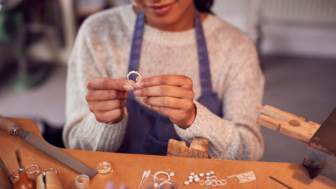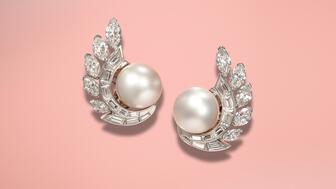We’ve Reached the Sustainability ‘Tipping Point,’ De Beers Says
It has become, and will continue to be, an important factor in diamond purchases, according to the 2021 Diamond Insight Report.

Price, design and, now, sustainability, a trend at least a decade in the making that’s now become an imperative for businesses, De Beers Group executives said Monday in an interview ahead of the release of the 2021 Diamond Insight Report.
As part of this year’s report, De Beers commissioned consulting firm GlobeScan to conduct a worldwide study on consumers and their attitudes toward sustainability, particularly as they pertain to natural diamonds.
What the study found is that consumers—particularly younger consumers—care about sustainability when buying a diamond and, what’s more, some of them are willing to pay a premium for it.
The issue of sustainability is quickly becoming “table stakes” for companies in the diamond business, said David Prager, De Beers executive vice president and chief brand officer.
“It won’t be a choice or an advantage to have a sustainable brand or product; it will be a must-have,” he said.
According to the study, nearly 60 percent of consumers will select a diamond from a brand that demonstrates that it operates in an environmentally and socially responsible way over one lacking sustainability assurances. Of those, 85 percent are open to paying an average premium of 15 percent.
The study also showed that the more important the occasion, the more likely consumers are to want a diamond that was produced responsibly.
Sixty-two percent of people buying natural diamonds for weddings, engagements and anniversaries rated sustainability factors as top priority in their purchasing decision.
That number dropped to 50 percent for diamonds women and men were buying for themselves, and 45 percent for diamonds purchased for other occasions, like Mother’s Day or Christmas.
Esther Oberbeck, De Beers’ senior vice president of strategy and analytics, has studied consumer behavior around diamonds for years.
She said with this most recent report, she was surprised at the geographical commonalities on sustainability it revealed, with consumers worldwide concerned about this issue.
The report also notes that sustainability concerns transcend age as well, though younger consumers— millennials in particular—are the current leaders in the movement, with Gen Z coming up behind as they gain more purchasing power.
The study found that 68 percent of millennials and 65 percent of Gen Zers have bought products because of their sustainability credentials, compared with 42 percent of baby boomers.
When it comes to jewelry specifically, 30 percent of millennials and 21 percent of Gen Zers have purchased jewelry with sustainability credentials, compared with only 8 percent of boomers.
Sustainability considerations are also higher among consumers with a higher education (67 percent) and from affluent backgrounds (70 percent), whom, it should be noted, are the ones with excess disposable income to spend on sustainable products.
The behavior of jewelry consumers is in lockstep with the broader global interest in sustainability in all sectors—not just diamonds and other luxury goods, but food, beauty products, household products, cars, and more.
“There is no doubt in my mind that this is not a fad,” Oberbeck said. “This is not going away. This is a mega-trend that is here to stay. I think consumers are telling us this message loud and clear.”
In the Diamond Insight Report, De Beers cited GlobeScan figures that show growing interest in issues of corporate social responsibility.
In 1999, GlobeScan conducted a study in which it asked consumers if they had considered rewarding a socially responsible company with a purchase or word-of-mouth referral. Less than half, 46 percent, said they had done so.
When asked that same question in 2020, 69 percent of consumers said yes.
In a GlobeScan Radar study conducted in 2010, 67 percent of consumers said they were interested in learning more about how companies were trying to be more environmentally and socially responsible.
By 2020, that percentage had risen to 86 percent.
And in another Radar study in 2015, less than half of consumers said they felt it was a company’s responsibility to have a “vision to make the world a better place.” Fast-forward to 2020, and that percentage stands at 64 percent.
Sustainability is an issue De Beers has been tracking—and investing huge amounts of money in—for years, starting with the launch of Forevermark in Hong Kong in 2008 through the introduction of De Beers Code of Origin in Las Vegas this year.
Prager said consumer interest in sustainability has accelerated over the past 18 months due to a confluence of factors: COVID-19; the social justice movement that started in the United States and spread worldwide; more people witnessing the first-hand effects of climate change; and more younger consumers reaching financial maturity.
All of this has brought society to what De Beers CEO Bruce Cleaver characterized as a “tipping point” for diamond purchases.
In the news release accompanying the report, Cleaver said: “With sustainability being one of the key mega trends across all consumer sectors, this year’s Diamond Insight Report explores how sustainability factors are influencing consumer attitudes towards diamonds.
“As is clear from this research, a tipping point has been reached—sustainability is no longer a trend that’s coming over the horizon; it’s already one of the key considerations in diamond purchases.”
The study is based on interviews with more than 8,400 people conducted in July.
GlobeScan connected with consumers in seven key markets for diamond consumption: the U.S., China, India, United Kingdom, France, Italy and South Africa.
Please check NationalJeweler.com in the near future for more analysis of the 50-plus page Diamond Insight Report, which can be viewed in its entirety on the De Beers website.
The Latest

The entrepreneur and “Shark Tank” star will share his top tips for success.

The Ukrainian brand’s new pendant is modeled after a traditional paska, a pastry often baked for Easter in Eastern European cultures.

The jeweler has announced a grand reopening for its recently remodeled location in Peoria, Illinois.

The “Strong Like Mom” campaign features moms who work at Tiffany & Co. and their children.


Interior designer Athena Calderone looked to decor from the 1920s and 1930s when crafting her first fine jewelry collection.

During a call about its full-year results, CEO Efraim Grinberg discussed how the company is approaching the uncertainty surrounding tariffs.

Bench jewelers spend years honing their skills, Jewelers of America’s Certification validates their talents.

The free program provides educational content for jewelry salespeople and enthusiasts to learn or refresh their diamond knowledge.

The feedback will be used to prepare other jewelers for the challenges ahead, the organization said.

The online sessions are designed to teach jewelers to use AI tools like ChatGPT and Claude to grow their business.

The opening marks the jewelry retailer’s first location in the Midwest.

The “United in Love” collection offers tangible mementos of hearts entwined with traditional and non-traditional commitment heirlooms.

Robert Goodman Jewelers will hold a “Black Jewelry Designers and Makers” event on April 27.

The announcements follow a tumultuous start to 2025 for WJA, which saw a wave of resignations following controversial statements about DEI.

Editor-in-Chief Michelle Graff answers questions about how the new taxes levied on countries like India and China will impact the industry.

Kenewendo, Botswana’s minster of minerals and energy, discusses closing the deal with De Beers and the work that was missed along the way.

The historic fancy vivid blue diamond set to headline Christie’s Geneva sale next month could sell for up to $50 million.

LVMH CFO Cécile Cabanis also discussed the effects of tariffs so far.

The “Mad Men” and “The Morning Show” star steals jewelry, art, and handbags from his wealthy neighbors in “Your Friends & Neighbors.”

The organization has reelected Kalpesh Jhaveri as president.

An investigation found that the former managing director of Movado’s Dubai branch overstated and prematurely recorded sales.

The collection pays tribute to the Japanese philosophy of Ma, studying balance, stillness, and the interplay between presence and absence.

Mari Lou’s Fine Jewelry in Orland Park, a suburb of Chicago, is closing its doors.

GIA’s labs in Dubai and Hong Kong are now accepting larger diamonds in light of the “logistical challenges” presented by the new tariffs.

These earrings by Van Cleef & Arpels, featuring the same design as a pair worn by Princess Grace, are up for auction at Woolley & Wallis.

Two experts share how artificial intelligence tools can help retailers run a more efficient business.





























